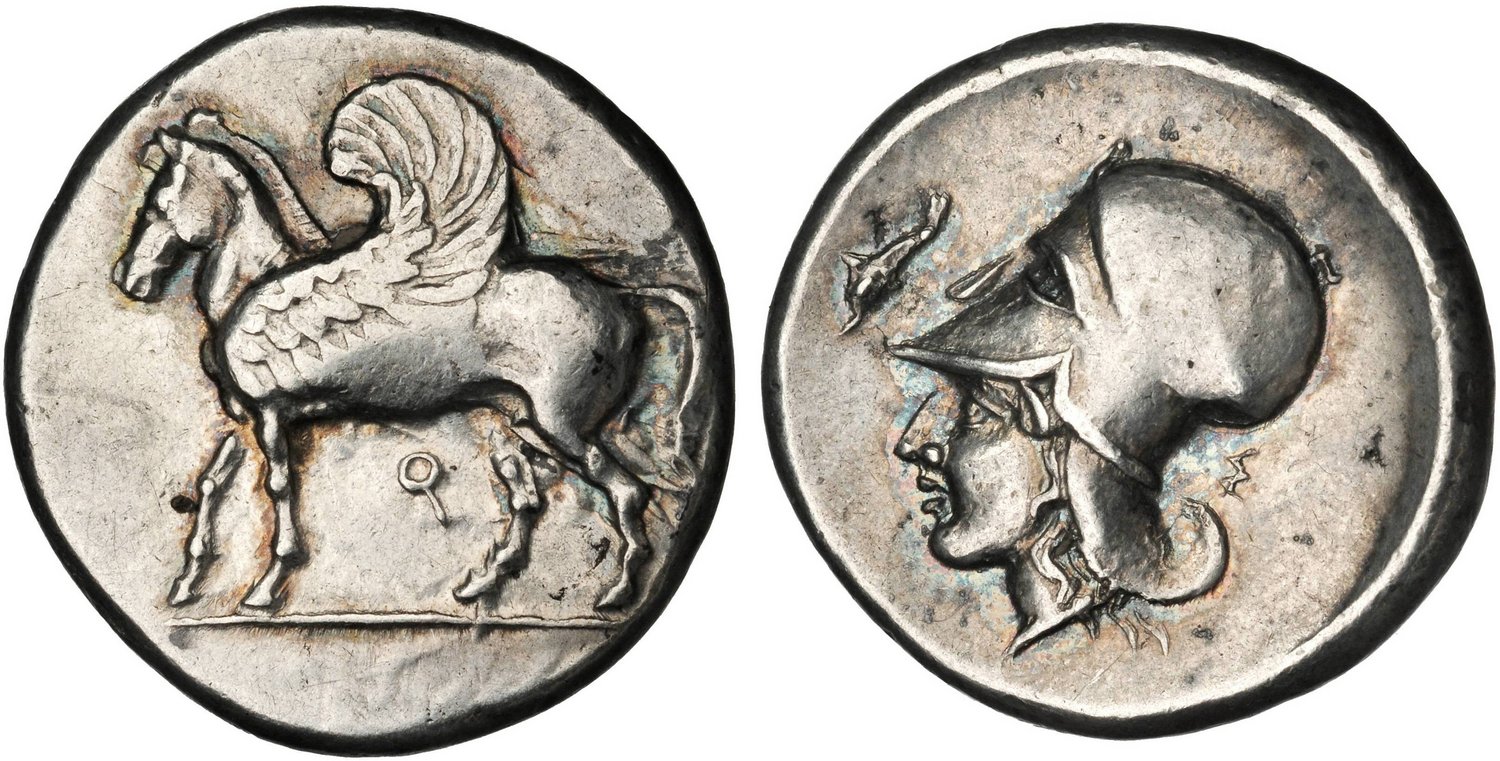1882 - Metapontum (nomos Leucippus/ear of barley) over Corinth (Pegasus/Athena) (London, BM, 1903-2-1.5): Difference between revisions
From SILVER
No edit summary |
No edit summary |
||
| (5 intermediate revisions by 2 users not shown) | |||
| Line 1: | Line 1: | ||
{{Overstrike | {{Overstrike | ||
|Image overstriking coin=SO 1260 - Metapontum over Dyrrhachium.jpeg | |||
|Image reference overstriking coin=https://www.britishmuseum.org/collection/object/C_1903-0201-5 | |||
|Image overstruck variety=Corinth_Calciati_342.jpg | |||
|Image reference overstruck variety=https://pro.coinarchives.com/a/lotviewer.php?LotID=553571&AucID=991&Lot=167 | |||
|Museum collection=London, British Museum, 1903,0201.5 | |Museum collection=London, British Museum, 1903,0201.5 | ||
|Private collection=Sir Henry Hoyle Howorth | |||
|Obverse description=Head of Leucippus right, wearing Corinthian helmet. In field, cross-torch. | |Obverse description=Head of Leucippus right, wearing Corinthian helmet. In field, cross-torch. | ||
|Reverse legend=META | |Reverse legend=META | ||
|Reverse legend language=Greek | |Reverse legend language=Greek | ||
|Reverse description=Ear of | |Reverse description=Ear of barley with leaf. In right field, H-T | ||
|Mint=Metapontum | |Mint=Metapontum | ||
|Ancient region= | |Ancient region=Lucania | ||
|Date from= | |Date from=339 BCE | ||
|Date to=330 BCE | |Date to=330 BCE | ||
|Period=Classical | |Period=Classical | ||
|Metal=Silver | |Metal=Silver | ||
|Weight=7. | |Weight=7.57 | ||
|Axis=12 | |Axis=12 | ||
|Denomination= | |Denomination=nomos | ||
|Standard=Achaian | |Standard=Achaian | ||
|Coin reference=HN Italy, n° 1555 | |Coin series reference=HN Italy, n° 1555 ; HGC 1, n° 1055 | ||
| | |Coin series web reference=https://greekcoinage.org/iris/id/metapontum.hn_italy.1555 | ||
|Overstruck mint= | |Overstruck obverse legend=Koppa below | ||
|Overstruck ancient region= | |Overstruck obverse legend language=Greek | ||
|Overstruck obverse description=Pegasus with curled wing standing left | |||
|Overstruck reverse description=Helmeted head of Athena left, dolphin in front, sigma behind | |||
|Overstruck mint=Corinth | |||
|Overstruck ancient region=Peloponnesus | |||
|Overstruck date from=405 BCE | |||
|Overstruck date to=345 BCE | |||
|Overstruck period=Classical | |||
|Overstruck denomination=stater | |||
|Overstruck standard=Aeginetic | |||
|Coin series reference overstruck=Calciati 1990, n° 342 | |||
|Coin series web reference overstruck=https://greekcoinage.org/iris/id/corinth.calciati.1990.period_iv.period_1-17 | |||
|Frequency of overstrikes=frequent | |||
|Level of confidence=strong | |||
}} | }} | ||
Latest revision as of 06:11, 15 December 2023
339 BCE - 330 BCE | META
Location/history
| Museum collectionMuseum collection: | London, British Museum, 1903,0201.5 | |
| Private collection(s)Private collection(s) ᵖ: | Sir Henry Hoyle Howorth |
Overstriking coin
Description
| ObverseInscription or printing placed on the obverse.: | Head of Leucippus right, wearing Corinthian helmet. In field, cross-torch. | ReverseInscription or printing placed on the reverse.: | META (Greek) Ear of barley with leaf. In right field, H-T |
Mint and issuing power
| MintIdentifies the place of manufacture or issue of a numismatic object.: | Metapontum | Ancient regionAncient region. | Lucania | Modern countryModern country: Italy | AuthorityIdentifies the issuing power. The authority can be "pretended" when the name or the portrait of X is on the coin but he/she was not the issuing power. It can also be "uncertain" when there is no mention of X on the coin but he/she was the issuing power according to the historical sources: |
Chronology
| FromIdentifies the initial date in a range assigned in a numismatic context. 339 BCE toIdentifies the final date in a range assigned in a numismatic context.. 330 BCE | Classical 480-323 BC |
Physical description
| MetalThe physical material (usually metal) from which an object is made.: Silver |
WeightWeight of the numismatic object (in grams). in grams: 7.577.57 g <br />7,570 mg <br /> | DenominationTerm indicating the value of a numismatic object. Examples: tetradrachm, chalkous, denarius.: nomos | AxisDescribes the directional relationship between the obverse and reverse of a numismatic object.: 1212 mm <br />1.2 cm <br /> |
| StandardStandard.: Achaian | |||
References
| Coin referenceReference of the Coin: | Coin series referenceReference to coin series study: | HN Italy1HN Italy, n° 1555, HGC 12HGC 1, n° 1055 | |
| Coin series web referenceCoin series web references: | |||
Overstruck type
Description
| ObverseInscription or printing placed on the obverse.: | Koppa below (Greek) Pegasus with curled wing standing left | ReverseInscription or printing placed on the reverse.: | Helmeted head of Athena left, dolphin in front, sigma behind |
Mint and issuing power
| MintIdentifies the place of manufacture or issue of a numismatic object. ᵖ: | Corinth | Ancient regionAncient region. ᵖ | Peloponnesus | Modern countryModern country: Greece | AuthorityIdentifies the authority in whose name (explicitly or implicitly) a numismatic object was issued. ᵖ: |
Chronology
| FromIdentifies the initial date in a range assigned in a numismatic context. 405 BCE toIdentifies the final date in a range assigned in a numismatic context.. 345 BCE | Classical 480-323 BC |
Physical description
| DenominationTerm indicating the value of a numismatic object. Examples: tetradrachm, chalkous, denarius. ᵖ: | stater |
StandardStandard. ᵖ: | Aeginetic |
References
| Coin type referenceReference to coin series study ᵖ: | Calciati 19903Calciati 1990, n° 342 | ||
| Coin series web reference overstruckCoin series web references overstruck: | |||
Additional data
| Frequency of overstrikesFrequency of overstrikes: | frequent | Level of confidenceLevel of confidence of the identification: | strong |
| RemarksRemarks: | |||
References
- ^ Rutter N. Keith et alii (eds.) (2001), Historia Numorum Italy, London, xvi, 223 p., 43 pl.
- ^ Hoover, Oliver D. (2018), The Handbook of Greek Coinage Series, Volume 1. Handbook of Coins of Italy and Magna Graecia, Sixth to First Centuries BC., Lancaster-London, 2018, lxi, 527 pages, 23 cm
- ^ Calciati, Romolo (1990), Pegasi, Mortara, Edizioni I.P..

